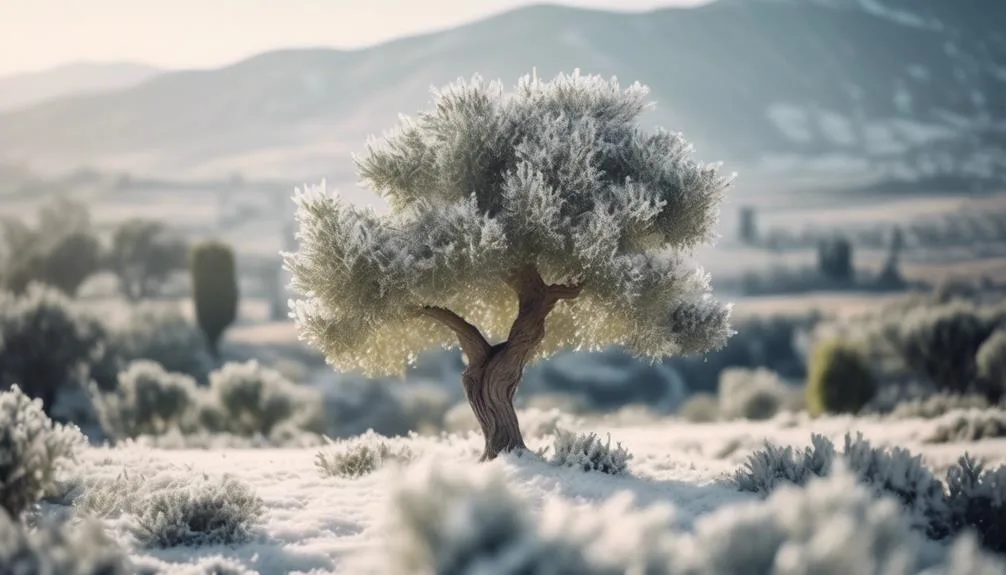Thinking about growing olive trees in a cold climate? It's not as impossible as you might think.
While olive trees are usually found in warm Mediterranean areas, it's actually feasible to grow them in colder climates with the right knowledge and techniques.
You could potentially have these iconic trees in your own backyard.
Let's explore the world of olive trees and their potential to thrive in unexpected environments.
Key Takeaways
- Olive trees can grow in cold climates, but they require specific care and protection during winter.
- Proper soil preparation, including well-draining soil with a pH level between 5.5 and 6.5, is essential for olive tree growth in cold climates.
- Pruning olive trees in late winter or early spring helps prevent frost damage and promotes overall tree health and resilience to cold temperatures.
- Using frost cloth or burlap to cover olive trees, applying mulch around the base, and keeping them well-watered in the fall are proactive measures to protect them from winter damage in cold climates.
Ideal Growing Conditions for Olive Trees
To successfully grow olive trees in cold climates, you should prioritize providing them with ideal growing conditions. Olive trees thrive in well-draining, alkaline soil with a pH level between 7 and 8.5. Ensure the soil is rich in organic matter and avoid waterlogged conditions as olive trees are susceptible to root rot.
When it comes to water needs, olive trees are drought-tolerant once established, but they require regular watering during the first few years after planting. Adequate sunlight exposure is crucial for olive trees, so ensure they receive at least 6-8 hours of direct sunlight daily.
In terms of temperature, olive trees can withstand temperatures as low as 15°F (-9°C) for short periods, but they thrive in a temperature range of 70-85°F (21-29°C) during the growing season.
Cold Tolerance of Olive Trees
When cultivating olive trees in cold climates, understanding their cold tolerance is essential for their successful growth and survival. Olive trees exhibit remarkable frost resistance and winter hardiness, making them suitable for moderately cold environments. Here's a quick look at the cold tolerance of olive trees:
| Frost Resistance | Winter Hardiness |
|---|---|
| Can tolerate light frosts, withstanding temperatures as low as 15°F for short periods. | Generally hardy to USDA Zone 7, capable of withstanding winter temperatures as low as 5°F when mature. |
Olive trees can endure mild winter conditions, but prolonged exposure to extreme cold may damage them. Therefore, it's crucial to provide adequate protection during harsh winter spells, especially for younger trees. Understanding the cold tolerance of olive trees will help you effectively care for them in cold climates and ensure their long-term health and productivity.
Tips for Growing Olive Trees in Cold Climates
Understanding the cold tolerance of olive trees sets the stage for implementing effective strategies to grow and care for them in cold climates, ensuring their vitality and productivity.
Soil preparation is crucial for olive trees in cold climates. Ensure the soil is well-draining and has a pH level between 5.5 and 6.5. Incorporate organic matter into the soil and consider using raised beds to improve drainage and soil warmth.
Additionally, pruning techniques play a vital role in helping olive trees thrive in cold climates. Prune your olive trees in late winter or early spring to remove any damaged or diseased branches and to shape the tree for better air circulation. This will help in preventing frost damage and promoting overall tree health, making it more resilient to cold temperatures.
Protecting Olive Trees From Winter Damage
Protecting your olive trees from winter damage requires proactive measures to ensure their survival and continued productivity in cold climates.
Winter protection is essential to shield the trees from frost damage. One effective method is to use frost cloth or burlap to cover the trees when temperatures drop. This helps to trap some heat and protect the trees from freezing.
Additionally, applying a thick layer of mulch around the base of the trees can insulate the roots and prevent them from freezing.
It's also crucial to keep the trees well-watered in the fall to help them withstand the cold and reduce the risk of winter damage.
Best Olive Tree Varieties for Cold Climates
To ensure the survival and productivity of your olive trees in cold climates, selecting the best olive tree varieties is essential. When choosing olive tree varieties for cold climates, it's important to consider factors such as cold hardiness, fruit production, and oil quality. Here are some of the best olive tree varieties for cold climates:
| Variety | Cold Hardiness | Fruit Production | Oil Quality |
|---|---|---|---|
| Arbequina | High | High | Excellent |
| Koroneiki | Medium | High | Excellent |
| Picual | High | High | Very Good |
These varieties have shown resilience in cold climates and are known for their high fruit production and excellent oil quality. To ensure the success of your olive trees in cold climates, proper pruning techniques and soil preparation are crucial. Selecting the right variety and providing adequate care will help your olive trees thrive despite the cold.
Conclusion
In colder climates, olive trees can thrive with the right care and protection. By choosing cold-tolerant varieties, providing winter protection, and selecting ideal growing locations, you can enjoy the beauty and benefits of olive trees even in chilly environments.
With the proper approach, you can successfully cultivate olive trees in colder regions and experience the joy of growing these resilient trees in non-traditional areas.

